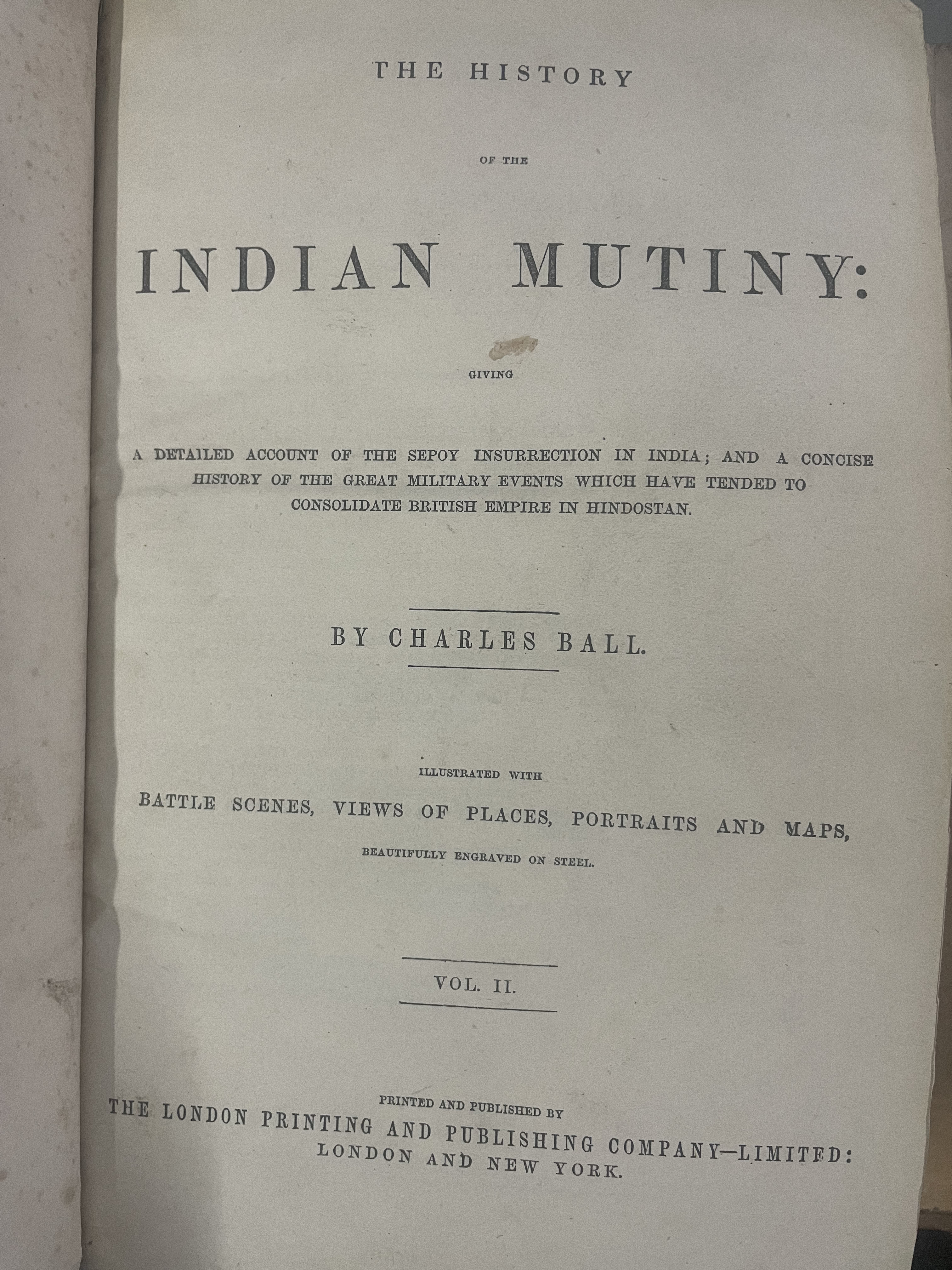The History of the Indian Mutiny vol II

About
Summary
Exquisite
TOC
Details
Related
URL
Images
Overview
Charles Ball's The History of the Indian Mutiny provides a detailed account of the Sepoy Rebellion of 1857-58, also known as India's First War of Independence. Published in volumes, this historical work offers a contemporary perspective on the complex events, figures, and underlying causes of the uprising against British rule.Charles Ball's The History of the Indian Mutiny: Giving a Detailed Account of the Sepoy Insurrection in India meticulously chronicles the events of the 1857-58 uprising. The work aimed to provide a comprehensive understanding of the revolt, exploring its origins, key events, and consequences. Ball’s history, published in several divisions intended to be bound in volumes, included steel-engraved portraits, views, and battle scenes, alongside detailed text.
Importance of Book
Contemporary Account: Ball's work provides a contemporary perspective on the events of the mutiny, offering insights into how the uprising was perceived and understood by British society at the time.
Detailed Narrative: The book offers a detailed narrative of the key events, battles, and figures involved in the mutiny. This level of detail makes it a valuable resource for historians seeking to understand the complexities of the conflict.
Visual Documentation: The inclusion of illustrations, portraits, and maps enhances the historical value of the book, providing a visual representation of the people, places, and events described in the text.
Key Themes
Causes of the Mutiny: Ball examines the various factors that led to the uprising, including political, economic, social, and religious grievances. The annexation policies of the East India Company, interference with religious customs, and discriminatory practices against Indian soldiers are explored as potential catalysts for the revolt.
Key Events and Battles: The book provides detailed accounts of the major events and battles of the mutiny, such as the sieges of Delhi and Lucknow, the Cawnpore massacre, and the heroic actions of figures on both sides of the conflict. These narratives offer a vivid picture of the violence and chaos that engulfed India during this period.
British Response and Retribution: Ball documents the British response to the mutiny, including the military campaigns to suppress the revolt and the subsequent acts of retribution against the rebels. The book likely portrays the complex dynamics of colonial power, resistance, and the often-brutal consequences of imperial control.
Impact on Anglo-Indian Relations: The mutiny profoundly impacted the relationship between the British and Indian populations. Ball's work likely explores the breakdown of trust, the rise of racial tensions, and the reshaping of colonial policies in the aftermath of the uprising.
Cultural Significance
Shaping British Perceptions: Ball's account likely contributed to shaping British perceptions of the mutiny and its causes. The book's portrayal of events and figures would have influenced public opinion and attitudes toward India and its people.
Commemoration and Remembrance: The book may have played a role in commemorating and remembering the events of the mutiny, both in Britain and India. Its narratives and images would have contributed to the collective memory of the conflict and its significance in the history of both nations.
Reinforcing Colonial Ideologies: As a product of its time, Ball's work may have inadvertently reinforced colonial ideologies and stereotypes about India and its people. Its portrayal of the mutiny may have served to justify British rule and reinforce notions of British superiority.
Effects on Society
In Britain: The book likely fueled public interest in India and the British Empire, contributing to a broader awareness of colonial affairs. It may have also reinforced support for British rule in India, particularly among those who viewed the mutiny as a threat to British power and prestige.
In India: The book's impact on Indian society is more complex. While it may have been read by some educated Indians, its primary audience was likely British. The book's portrayal of the mutiny may have contributed to a sense of resentment and anger among Indians who viewed the uprising as a legitimate struggle for independence.
Long-Term Impact on Historical Memory: Ball's work, along with other contemporary accounts, helped to shape the long-term historical memory of the mutiny in both Britain and India. Its narratives and interpretations have influenced subsequent historical scholarship and popular understandings of the conflict.
Conclusion
Charles Ball's The History of the Indian Mutiny serves as a valuable historical resource for understanding the complexities of the Sepoy Rebellion of 1857-58. Its detailed narrative, visual documentation, and contemporary perspective offer insights into the causes, events, and consequences of this pivotal moment in Anglo-Indian history. By examining Ball's work, we can gain a deeper appreciation of the cultural, social, and political dynamics that shaped the uprising and its lasting impact on both British and Indian society.
Title
The History of the Indian Mutiny vol II
Author
Charles Ball
Name of Publisher
The London Printing and Publishing Company
Publish Date
1857
Subject
An account of the Indian Rebellion of 1857
Vintage
1801-1900
Number of Pages
664
Category
History
Sub Category
Indian freedom
Rarity
RARE
